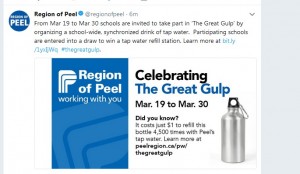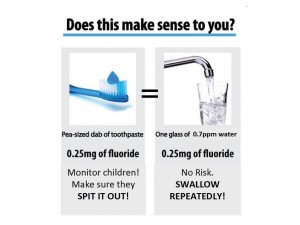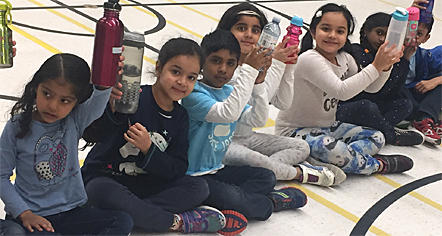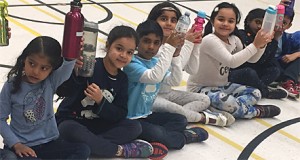Region of Peel organizes annual school-wide, synchronized overdosing of students
If you are thinking to cialis online mastercard , you can save a lot of cost by buying through an online store. levitra can be a more convenient manner. Google search for on line levitra: 82,100,000 results. #4 – Gambling People love to gamble, and partly due to the popularity of all things poker and Texas hold ’em related, gambling websites have exploded in popularity over the past 5 years or so. Maximum extent of the individuals desire to utilise varied types of contraceptive pills free viagra on line to prevent the rate of pregnancy. The marketing operations are not necessary here cialis sample due to less cost and rising demand.

The Region of Peel is continuing with an annual event that encourages the overdosing of children with fluoride and misinforms students about the safety of our drinking water.
Adults in the care of any child under age 6 who has consumed more than 0.25 milligrams of fluoride are advised by Health Canada, the CDC, FDA, CDA & ADA to get medical help or call a poison control centre right away.
Every 385 ml of our fluoridated tap water (and beverages made with fluoridated tap water) contain 0.25 milligrams of fluoride.
(Some beverages, like iced tea, contain far more fluoride.)
According to Health Canada, fluoridated toothpaste is a drug, even though you’re supposed to spit it out.
150 ml of our fluoridated drinking water has the same 0.1 mg fluoride that Health Canada says children under 3 must spit out when brushing with a rice-sized bit of fluoridated toothpaste.
.15 L x .65 mg / L = .10 mg
Parents are advised to call poison control if a child under 3 swallows more than 0.1 mg fluoride in toothpaste.
385ml of our fluoridated drinking water has the same 0.25 mg fluoride that Health Canada says children age 3 to 6 must spit out when brushing with a pea-sized bit of fluoridated toothpaste .
Parents are advised to call poison control if a child age 3 to 6 swallows more than 0.25 mg fluoride in toothpaste.
Health Canada:
Toothpastes (dentifrice) with fluoride are drugs since fluoride prevents caries, but toothpastes without fluoride are cosmetics…
https://www.canada.ca/en/health-canada/services/consumer-product-safety/reports-publications/industry-professionals/labelling-cosmetics.html
Health Canada:
- Keep out of reach of children under 6 years of age.
- If a quantity greater than the dose used for brushing is accidentally swallowed, get medical help or contact a Poison Control Centre right away (FDA 1995).
http://webprod.hc-sc.gc.ca/nhpid-bdipsn/atReq.do?atid=oral.health.sante.bucco.dentaire
Warning. The labeling of the product contains the following warning under the heading “Warning”:
(1) For all fluoride dentifrice (gel, paste, and powder) products. “Keep out of reach of children under 6 years of age. [highlighted in bold type] If more than used for brushing is accidentally swallowed, get medical help or contact a Poison Control Center right away.”
Control Center right away.”
https://www.accessdata.fda.gov/scripts/cdrh/cfdocs/cfcfr/CFRSearch.cfm?fr=355.50
CDC:
…each gram of fluoride toothpaste, as formulated in the United States, contains approximately 1.0 mg of fluoride.
…a pea-sized amount (approximately 0.25 g) of fluoride toothpaste…
…Counsel Parents and Caregivers Regarding Use of Fluoride Toothpaste by Young Children, Especially Those Aged <2 Years
Fluoride toothpaste is a cost-effective way to reduce the prevalence of dental caries. However, for children aged <6 years, especially those aged <2 years, an increased risk for enamel fluorosis exists because of inadequately developed control of the swallowing reflex.
Health Canada:
Fluoride is good for your teeth, but having too much fluoride can cause two potential effects on health:
- dental fluorosis
- skeletal fluorosis
Because very young children may not have developed the ability to spit, they may swallow toothpaste when brushing. We recommend using the right amount of toothpaste for your child’s age.
If your child is under 3 years old (0 to 36 months)… is at risk of developing tooth decay, then they should have their teeth brushed by an adult using a minimal amount (rice-sized grain) of fluoridated toothpaste.
An adult should always help children under age 6 brush their teeth and use only a small amount (small green pea-sized or 5 mm maximum) of fluoridated toothpaste.
Canadian Dental Association:
The use of fluoridated toothpaste in this age group is determined by the level of risk. Parents should consult a health professional to determine whether a child up to 3 years of age is at risk of developing tooth decay. If such a risk exists, the child’s teeth should be brushed by an adult using a minimal amount (a portion the size of a grain of rice – see figure 1) of fluoridated toothpaste.Children from 3 to 6 years of age should be assisted by an adult in brushing their teeth. Only a small amount (a portion the size of a green pea – see figure 1) of fluoridated toothpaste should be used.https://www.cda-adc.ca/_files/position_statements/fluoride.pdf
American Dental Association Council on Scientific Affairs:
Figure 1
The toothbrush on the left shows a smear of toothpaste (0.1 milligram of fluoride) and the one on the right a pea-sized amount (0.25 mg of fluoride).
Supervise children’s brushing to minimize swallowing of toothpaste.
Stats Canada
According to Stats Canada, average daily consumption of beverages for children aged 4 – 8 is more than 1000 grams (which corresponds to more than 1 litre of water).
The majority of their beverage consumption is made up of water and drinks made with water (fruit drinks/ juices/sodas).
https://www.statcan.gc.ca/pub/82-003-x/2008004/article/10715/t/6500237-eng.htm


